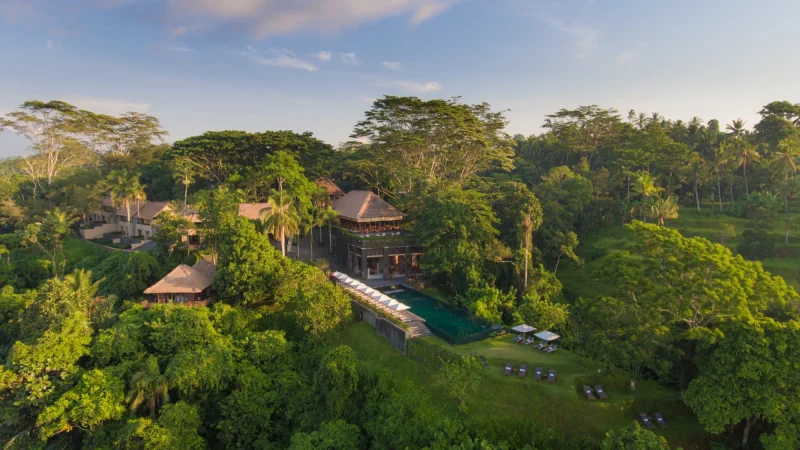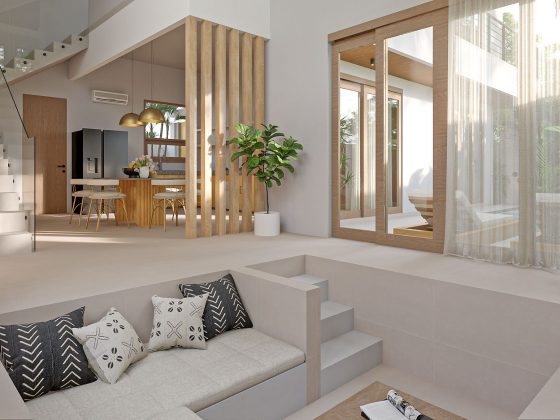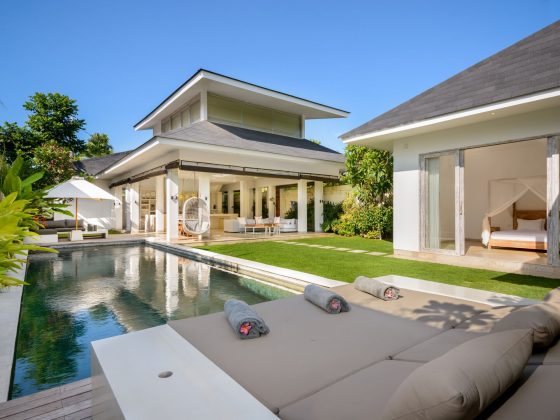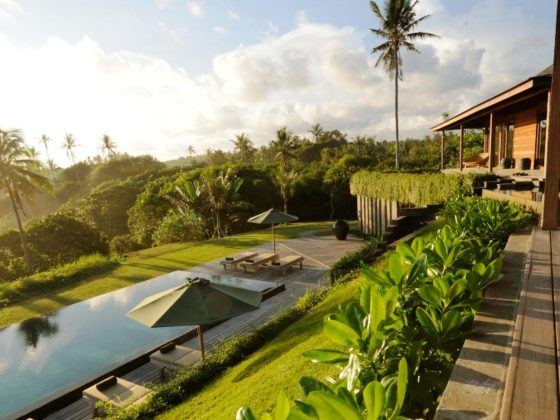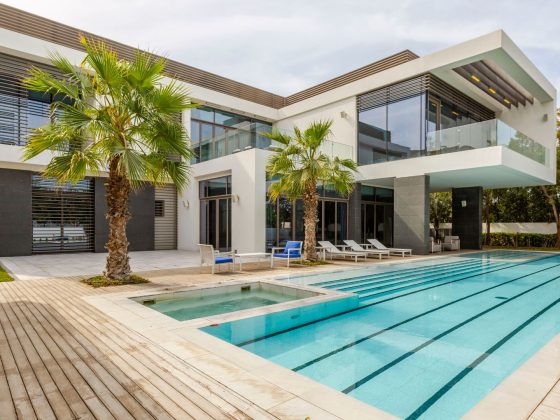Bali is undergoing a major transformation in its real estate landscape, and sustainability is at the forefront. Eco-friendly developments are gaining traction as developers and investors recognize the importance of aligning with Bali’s commitment to sustainable tourism. This is not a trend but a response to the growing demand for properties that merge modern living with environmental conservation.
Eco-Friendly, Eco-Conscious Architecture
Modern developments in Bali are embracing green architecture, renewable energy solutions, and environmentally friendly materials. These initiatives aim to reduce the carbon footprint and promote sustainable living by focusing on sustainable production practices. The process of implementing renewable energy solutions and eco-friendly materials is crucial in minimizing the environmental impact of these developments. For instance, using aluminum as a sustainable material option in packaging and construction helps reduce waste and supports a circular economy. Properties feature solar panels, rainwater harvesting systems, and natural ventilation designs to minimize energy consumption.
In Uluwatu, a region famous for its cliffs and surf spots, luxury resorts like Alila Villas Uluwatu are leading the way. They integrate sustainability without compromising on luxury, offering guests an eco-friendly yet luxurious experience. These resorts were created with sustainability in mind, showcasing a commitment to reducing waste and promoting environmentally responsible practices.
Introduction to Eco-Conscious Architecture and Natural Resources
Eco-conscious architecture refers to the thoughtful design and construction of buildings that aim to minimize harm to the environment while promoting sustainability. This approach focuses on reducing the environmental impact of buildings and creating a more sustainable future for future generations. By utilizing natural resources, such as natural fibers and recycled materials, eco-conscious architecture seeks to reduce waste and lessen the carbon footprint of buildings.
The primary goal of eco-conscious architecture is to create structures that are environmentally friendly, energy-efficient, and sustainable. This involves incorporating design principles that not only reduce environmental impact but also provide a healthy and comfortable living space for occupants. As the world grapples with the challenges of climate change, pollution, and resource depletion, the importance of eco-conscious architecture continues to grow.
Companies and organizations are increasingly seeking to invest in eco-conscious architecture as a means to reduce their environmental impact and enhance their brand reputation. In Bali, for example, eco-conscious architecture is being used to create sustainable and environmentally friendly buildings that blend seamlessly into the island’s vibrant culture and natural landscape. This approach not only helps to reduce costs but also improves the overall quality of life for building occupants. Certifications like 1% For the Planet and Climate Neutral play a crucial role in promoting transparency and accountability in these eco-friendly practices.
As the demand for sustainable and environmentally friendly buildings continues to rise, eco-conscious architecture is poised to become a crucial aspect of the construction industry. By prioritizing sustainability, architects and builders can create a better future for our planet and future generations. It is essential to verify eco-friendly claims to avoid greenwashing and ensure that the products and practices truly contribute to sustainability.
Principles of Eco-Conscious Design and Environmental Impact
The principles of eco-conscious design focus on reducing the environmental impact of buildings and promoting sustainability. These principles involve the use of natural materials, energy-efficient systems, and sustainable design techniques to minimize waste and reduce the carbon footprint of buildings. By preserving natural resources for future generations, eco-conscious design aims to create a harmonious balance between the built environment and the surrounding ecosystem. Analysis is crucial in evaluating the effectiveness of these eco-friendly practices.
Eco-conscious design principles can be applied to a wide range of building types, from residential homes to commercial offices and public buildings. By incorporating these principles, architects and builders can create structures that are not only sustainable but also healthy, comfortable, and aesthetically pleasing. Examples of eco-conscious design elements include green roofs, solar panels, and rainwater harvesting systems, all of which contribute to reducing the environmental impact of buildings. Clearly defined eco-friendly standards are essential to avoid misunderstandings and ensure that these practices are effectively implemented.
In addition to building design, eco-conscious principles can also be applied to packaging and waste management. By promoting the use of recycled materials and minimizing waste, these principles help to reduce the environmental impact of construction and other industries. In the context of land development, eco-conscious design can help to preserve natural habitats and reduce the impact of construction on the surrounding ecosystem.
The principles of eco-conscious design can also be extended to the creation of sustainable and environmentally friendly brands and products. By prioritizing sustainability, companies and organizations can reduce their environmental impact and improve their reputation among consumers. As more consumers seek out sustainable options, the focus on eco-conscious design will continue to grow, driving innovation and positive change in the construction industry and beyond.
Eco-Friendly Building Materials
Eco-friendly building materials are an essential component of sustainable construction, as they minimize the environmental impact of buildings on the planet. These materials are created from natural resources, such as natural fibers, and are designed to reduce waste and conserve energy. By using eco-friendly materials, companies can reduce their environmental footprint and create a more sustainable future for future generations. The use of these materials not only helps in conserving natural resources but also ensures that the buildings are healthier and more comfortable for occupants. As the world moves towards more sustainable practices, the demand for eco-friendly building materials continues to grow, making it a crucial aspect of modern construction.
Exploring Sustainable Material Options
There are many sustainable material options available for building construction, including recycled materials, sustainable wood, and low-carbon cement. These materials can be used to create a wide range of building components, from walls and floors to roofs and insulation. By exploring these options, consumers can find products that are not only environmentally friendly but also cost-effective and durable. For example, bamboo is a highly renewable resource that can be used for flooring, walls, and other building components. Its rapid growth rate and strength make it an excellent alternative to traditional building materials. Additionally, recycled materials such as reclaimed wood and recycled metal can provide unique aesthetic qualities while reducing the demand for new raw materials.
Benefits of Using Eco-Friendly Materials
The benefits of using eco-friendly materials are numerous and include reducing the environmental impact of building construction, conserving natural resources, and creating a healthier indoor environment. Eco-friendly materials can also help to reduce energy consumption and lower costs over the life of the building. Additionally, using eco-friendly materials can enhance the aesthetic appeal of a building, making it a more desirable and valuable property. In Bali, for instance, many featured properties incorporate eco-friendly materials and sustainable design principles to create a unique and vibrant culture. These properties not only blend seamlessly with the natural landscape but also offer modern amenities that attract eco-conscious investors and residents. By prioritizing the use of eco-friendly materials, developers can create buildings that are both beautiful and sustainable, ensuring a better quality of life for occupants and a healthier planet for future generations.
Designing for Sustainability
Designing for sustainability involves creating buildings that are environmentally friendly, socially responsible, and economically viable. This can be achieved through a range of strategies, including building orientation and layout, water conservation and management, and the use of sustainable materials. By focusing on these aspects, architects and builders can create structures that not only minimize their environmental impact but also provide a comfortable and healthy living environment for occupants. Sustainable design is not just about reducing energy consumption; it also involves creating spaces that promote well-being and harmony with the natural environment.
Building Orientation and Layout
Building orientation and layout can have a significant impact on the environmental sustainability of a building. By carefully designing the orientation and layout of a building, architects can reduce the need for heating and cooling, minimize energy consumption, and maximize natural light and ventilation. This can be achieved through the use of techniques such as passive solar design, which involves orienting buildings to maximize natural light and heat. In France, for example, many buildings are designed with a focus on energy efficiency and sustainability. These buildings often feature large windows to capture natural light, strategic placement of rooms to optimize airflow, and the use of materials that enhance thermal insulation. By considering the local climate and environmental conditions, architects can create buildings that are both energy-efficient and comfortable.
Water Conservation and Management
Water conservation and management are critical components of sustainable building design. By using water-efficient appliances and fixtures, and implementing rainwater harvesting and greywater reuse systems, buildings can significantly reduce their water consumption and minimize their impact on the environment. This can be particularly important in areas where water is scarce, such as on island communities or in areas with limited access to natural resources. In the world of real estate, companies like Kibarer Property are leading the way in sustainable design and construction, with a focus on creating eco-friendly and environmentally responsible buildings that minimize waste and reduce the environmental impact of construction. By prioritizing water conservation and management, these companies are setting a standard for sustainable development that benefits both the environment and the communities they serve.
Pererenan: A Model for Sustainable Development
Pererenan, a peaceful village near Canggu, is a shining example of sustainable development in paradise. Living in this idyllic location is a dream for those seeking a harmonious blend of natural beauty and vibrant culture. The community in collaboration with local village administrations (banjar) prefer strict regulations to prevent over-commercialization and ensure development aligns with environmental and cultural values.
Innovative projects like Bawa House showcase sustainable living by using local materials and designs that reflect Balinese traditions. These developments not only preserve the area’s natural beauty but also offer modern amenities, attracting eco-conscious investors and residents alike.
Investment Opportunities in Eco-Friendly Properties
Purchasing eco-friendly properties in Bali offers many benefits:
- Income Potential: These properties can generate rental income due to the high demand for sustainable accommodations.
- High Demand: With the global shift towards sustainability, there is a growing market for eco-friendly accommodations among tourists and residents on the island.
- Strong ROI: Properties that emphasize sustainability often have higher occupancy rates and can command higher rental prices.
- Long Term Value: Eco-friendly developments are more resilient to environmental regulations and changing market preferences, so they have long-term viability.
- Featured Properties: Unique eco-friendly listings stand out, attracting discerning buyers and renters.
Developers are also offering flexible ownership structures such as leasehold agreements and PT PMA (foreign investment) options, making it easier for international investors to access Bali’s sustainable real estate market.
Bali’s commitment to sustainability is redefining its real estate sector, offering opportunities that merge luxury with environmental responsibility. Areas like Uluwatu and Pererenan are leading the way, providing models for eco-friendly development that respect local culture and nature.
Interested in eco-friendly properties in Bali? Let us lead you to your dream profitable investment. Contact us today!
